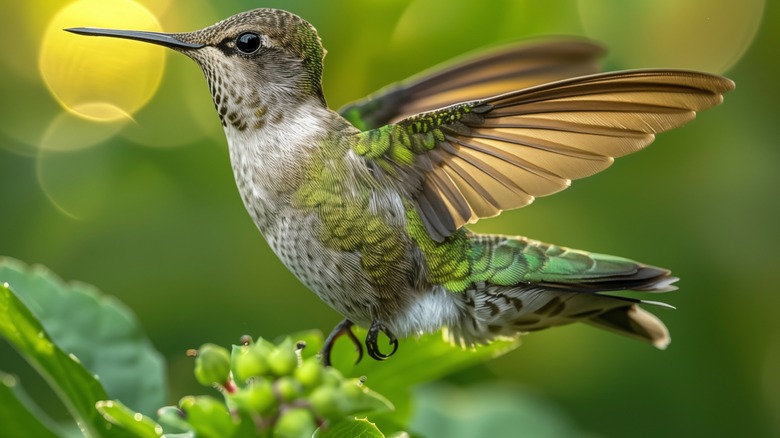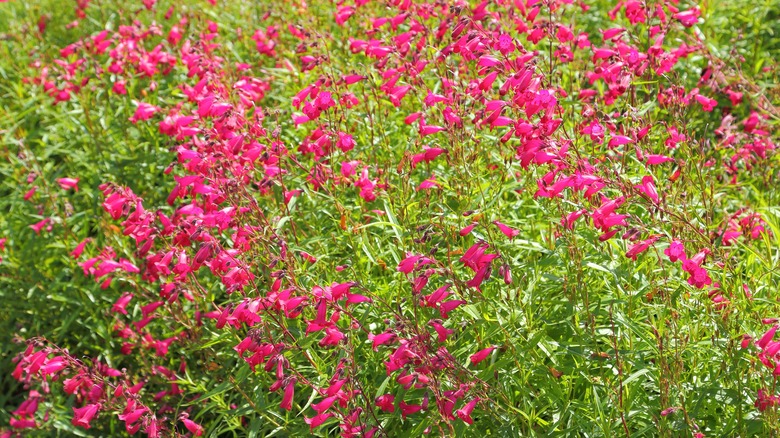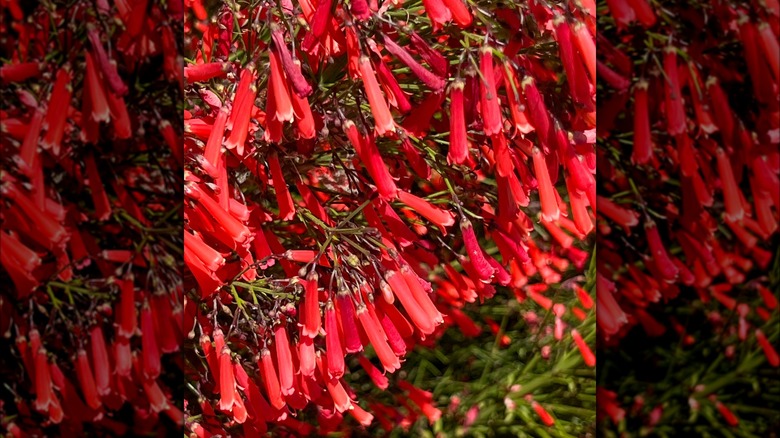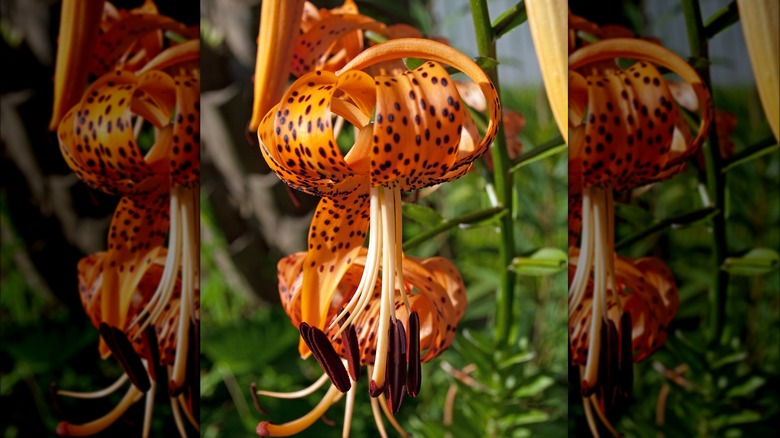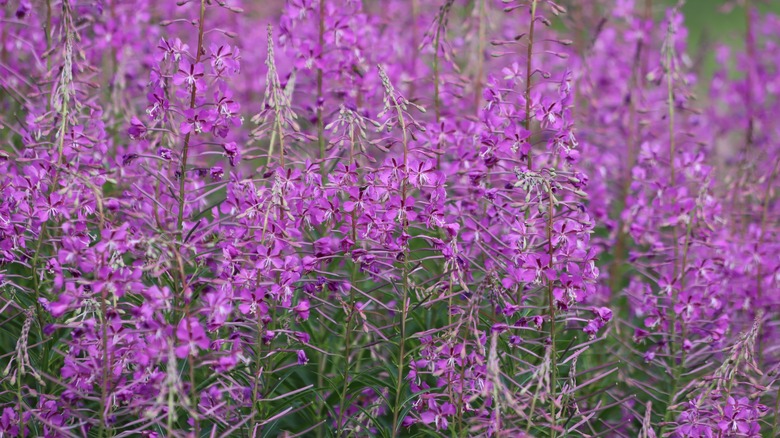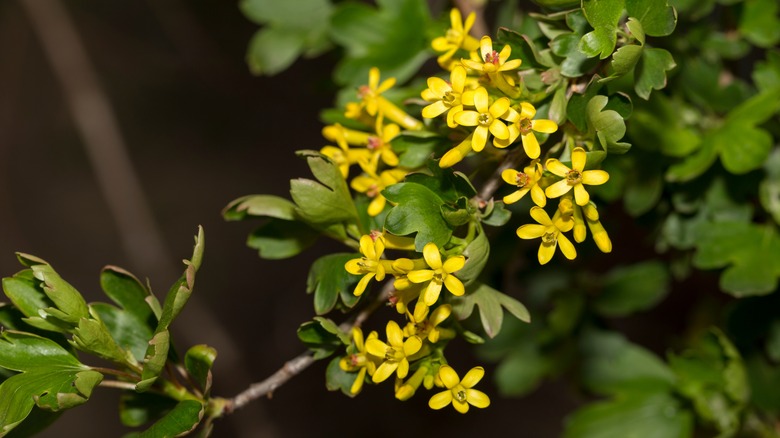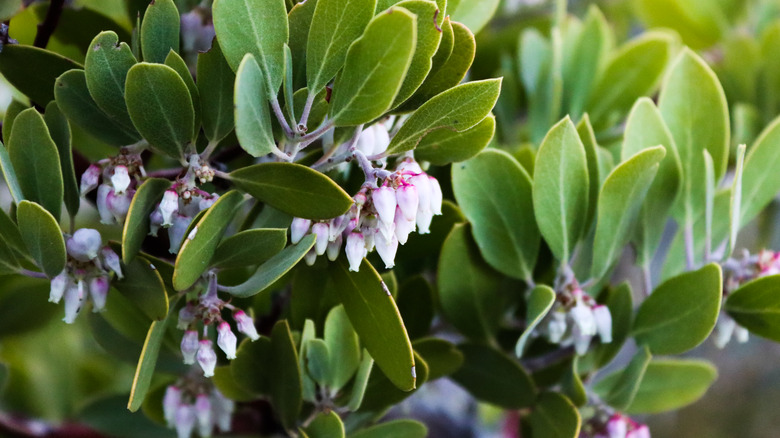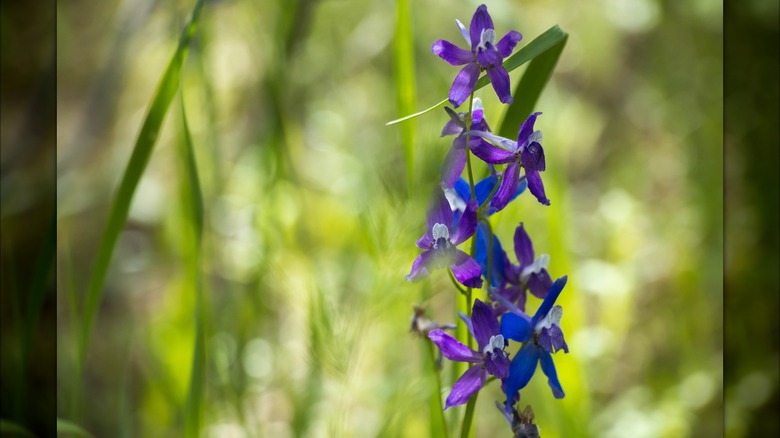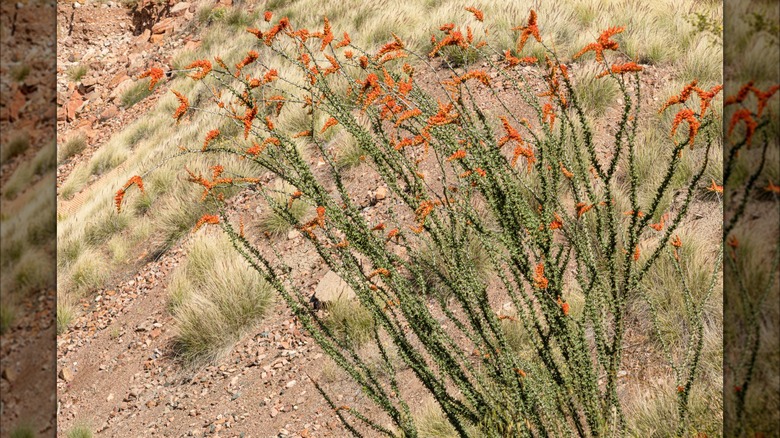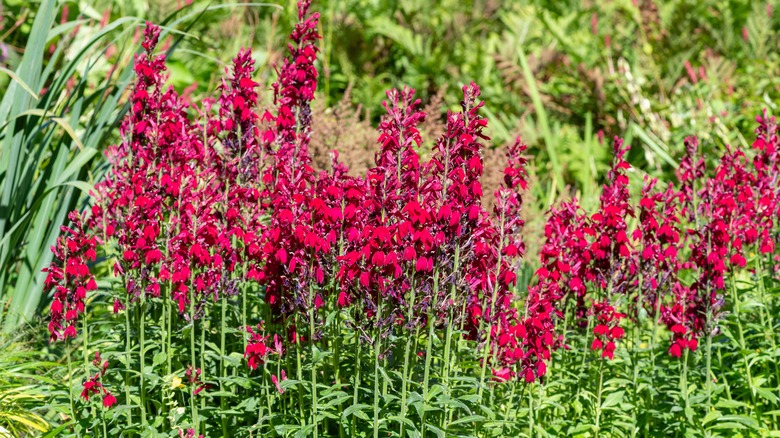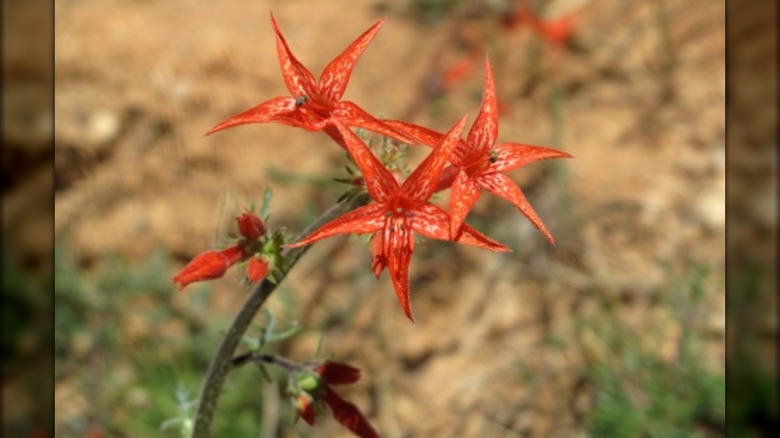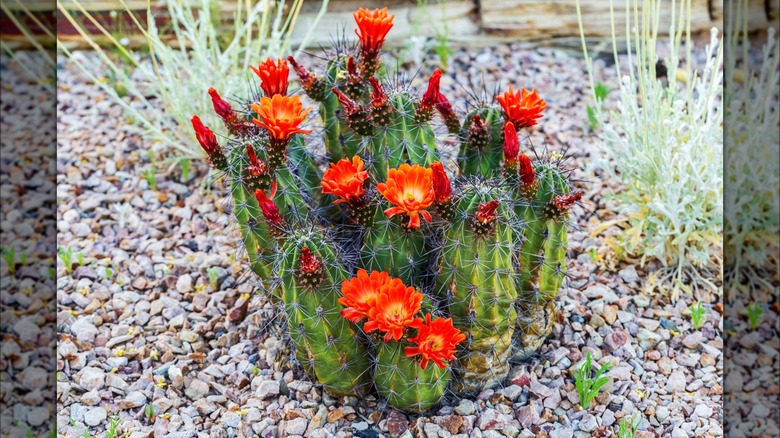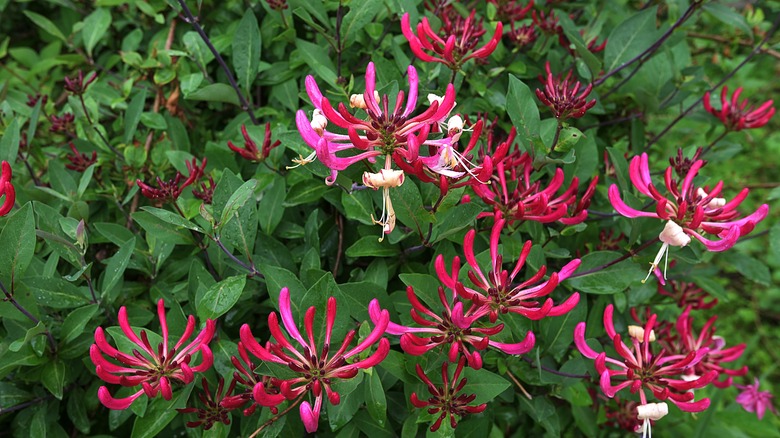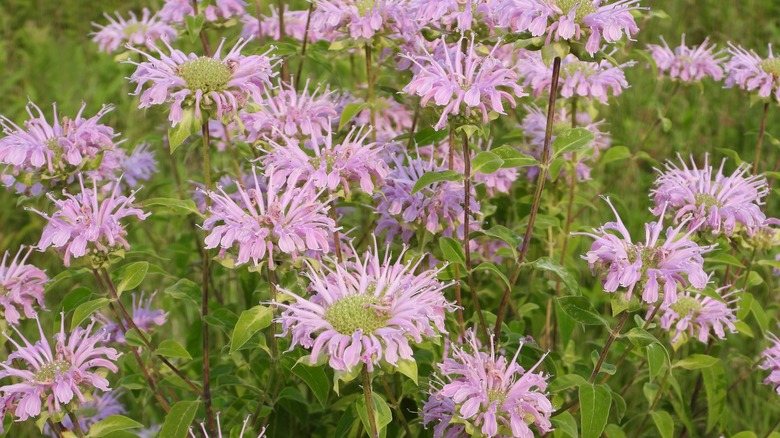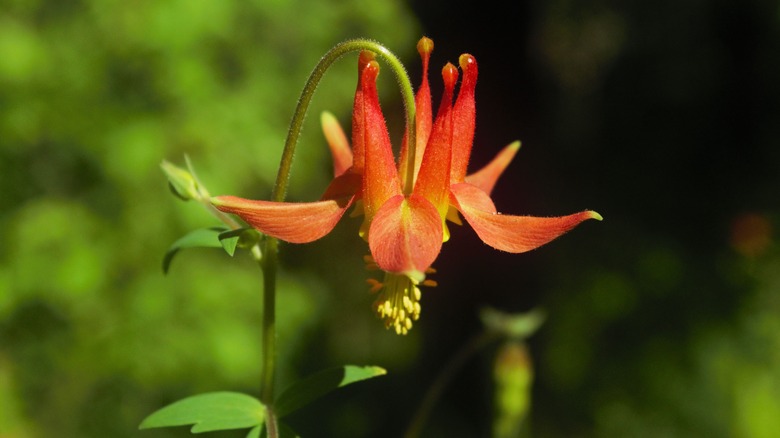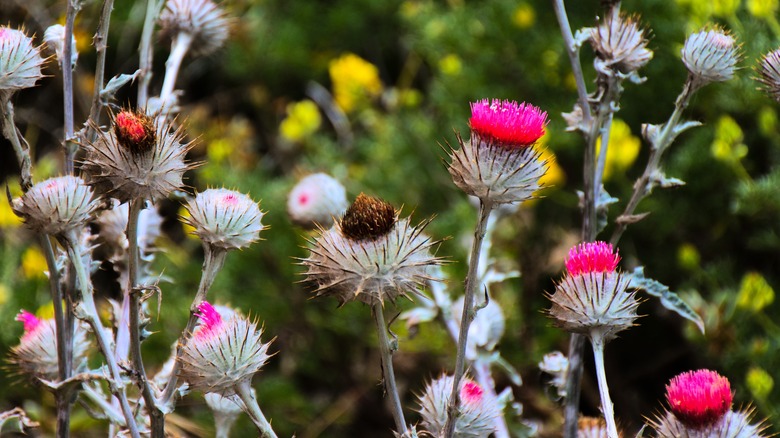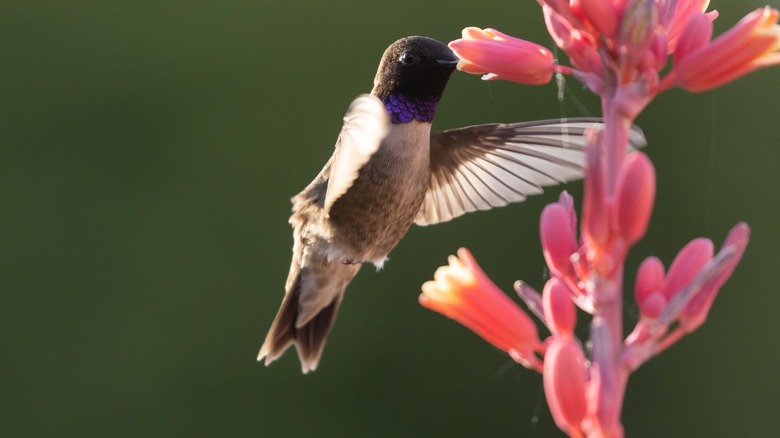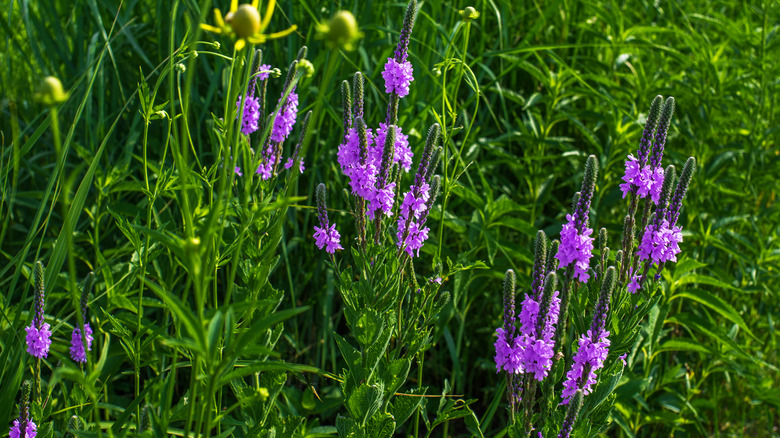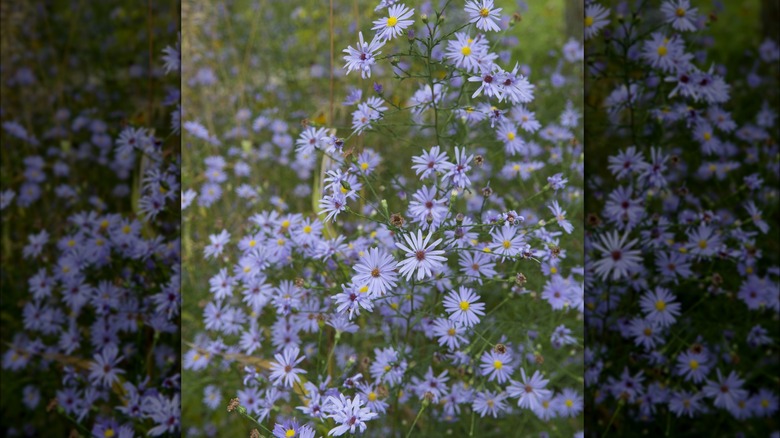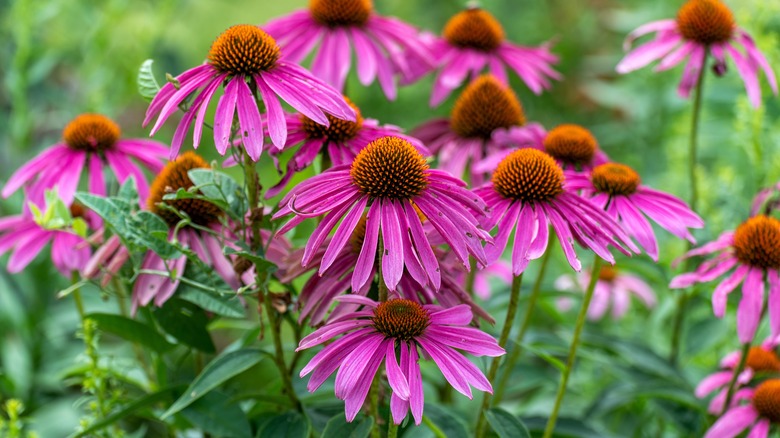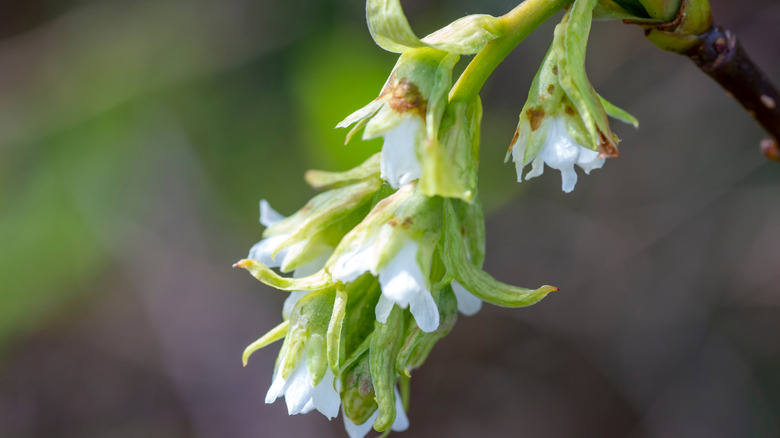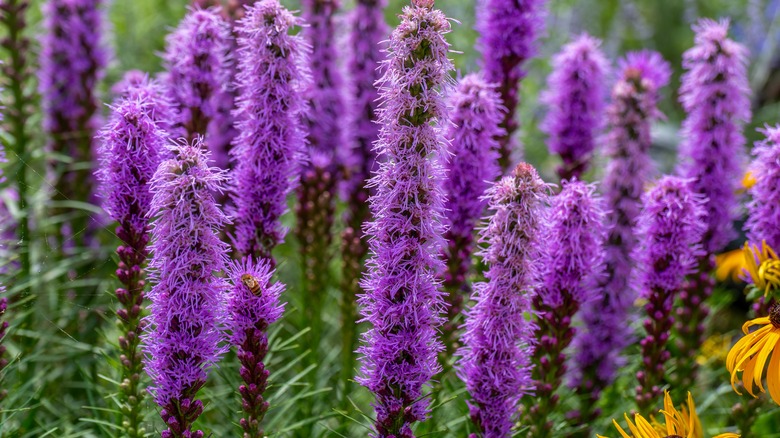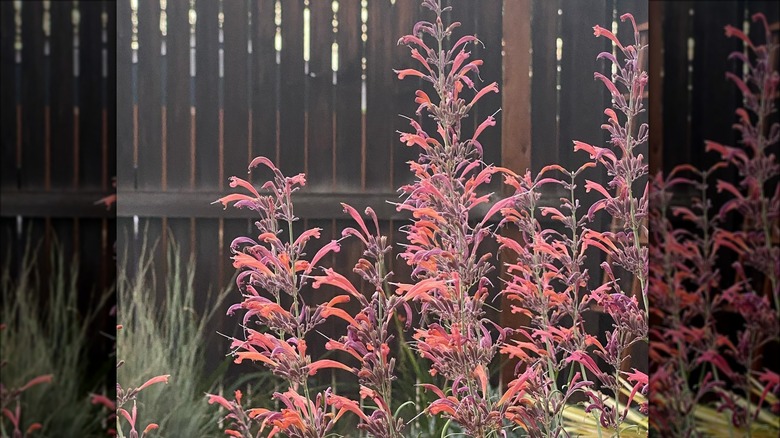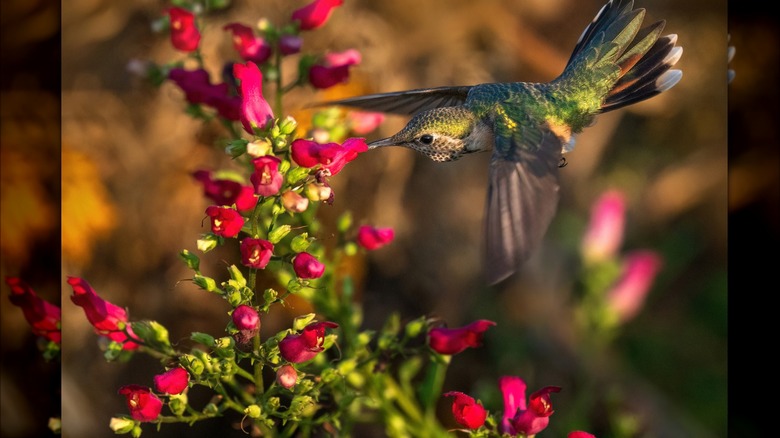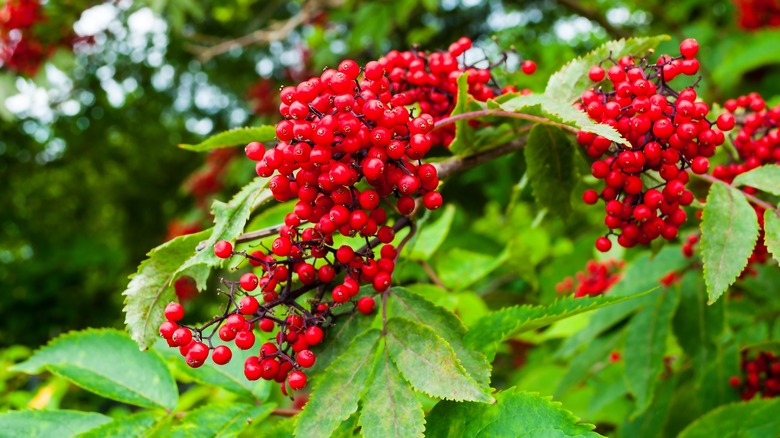24 Native Plants For A Sustainable Approach To Attracting Hummingbirds
Stepping out into the yard and chancing upon hovering hummers reaching hungrily for their feeders is an indescribably joyous and innately moving sight. So profound is its impact that it stirs gardeners into doing more for this beautiful Aves species, such as keeping tabs on predators that could be eating hummingbirds — including our dearest cats — or delighting them with misters and perches. Some even tolerate the pesky weeds for fear of depriving the jeweled birds of insect protein, otherwise lost to the work of chemical treatments. Best of all, they've become conscious of their planting selections, deliberately growing a litany of native plants that hummingbirds adore, especially as alternate food sources.
Native plants are often praised for being low maintenance, non-invasive (albeit occasionally aggressive), and better adept at responding to and dealing with changing ecological conditions. Besides, a host of them have co-evolved with hummingbirds, sharing similar growing and breeding grounds. For attracting hulking hummer gatherings, these native flowers are impeccable yet sustainable planting choices, and you can usually tell them apart from their red, tubular flowers — although the zapping birds do flock to other flowering plants when the former haven't yet bloomed during spring, such as golden currant and Manzanita flowers. Knowing that, learn about the native plants that'll swathe your landscape with gorgeous flowers dotted by scintillating hummers. But, ensure they're local to your area before planting; the National Wildlife Federation's Native Plants Finder tool may help.
1. Bearded penstemon
Native to the hilly tracts of Colorado and New Mexico, along with some presence in Utah, Arizona, and Texas, Beardlip or bearded penstemon (Penstemon barbatus) plants are a major draw for hummers, especially Costa's hummingbird. They're admired for their scarlet red (rarely white or yellow), shark-head-like, two-lipped flowers that persist from spring through summer. Deadheading won't induce reblooming but will encourage leafy growth that'll tinge winters in shades of green. Preference for infertile soils and vertical clumping makes penstemon appropriate for xeric or dry sites receiving extensive sun attention. Ensure good drainage to prevent root rot.
2. California fuchsias
Hummingbirds, particularly Anna's, congregate around the reddish-orange funnel flowers of California fuchsia (Epilobium canum), especially in late summer and fall when most other plants have exhausted their blooms. However, the territorial birds may have to compete against famished carpenter bees who nick the blossoms to steal the nectar. Local to several western states, including California, Idaho, and Oregon, California fuchsia lends most color to arid, sunny sites, reinforced further by its high heat, drought, and wind tolerance. Remember to prune the fire-resistant plant pre-winter to ensure its healthy return next year, though it'll self-seed, too.
3. Columbia lily
Columbia lily's (Lilium columbianum) red mottled, orange flowers might curtsy the ground. However, that doesn't stop rufous hummingbirds, bees, and butterflies from slurping their sweet nectar from late spring to summer. Also known as Oregon lilies, they're best suited for moderately shaded gardens in the west US, including California, Idaho, Washington, and Montana, provided the soils drain well. They mature to 6 feet tall, looking their best in hedgerows. While they can be started with seeds, you'll have to wait many years for flowers. So, to get in early on hummer action, either get their bulbs or offsets.
4. Fireweed
Named after its propensity to dominate incinerated ground, fireweed (Chamerion angustifolium) is a gorgeous, pollinator-friendly perennial that's endemic throughout the US, barring the scorching southeastern region. Fireweeds look fetching with their 4-foot-tall stature topped by pink, saucer blooms, or at least that's what black-chinned hummingbirds and their brethren insinuate. Remove spent blooms to encourage new flushes and keep the plant contained, as it can produce over 80,000 seeds in its lifetime. Separate the clumps in fall or spring to prevent rhizomes from taking over unless you're striving for an informal or cottage design. Watch for slugs and snails.
5. Golden currant
Golden currant (Ribes aureum) paints California, South Dakota, Texas, and Arizona's towns yellow in spring with its sweet-smelling blossoms, magnetizing hummingbird species like calliope. Don't deadhead the flowers as they turn orangish-mauve; rather, allow them to produce their black fruit, as they will service several songbirds or can be baked into pies if you outsmart the birds. Golden currant plants can be grown as accents, understories, or hedges if they receive sufficient sunlight to maintain their bushy growth. However, they may be disallowed in states with commercial white pine plantations, as they play host to blister rust fungus.
6. Manzanita
Comprising over 50 species native to western US states, particularly California and Arizona, Manzanita (Arctostaphylos spp.) is an exquisite groundcover, shrub, or tree (depending on the variety), appreciated by gardeners, hummingbirds, and other pollinators. The evergreen beauty is overlaid by pink or white urn-shaped blooms in winter right through spring, keeping its admirers, like Anna's hummingbirds, fueled up on nectar. It later brightens summers with apple-shaped fruits that pop out until the first frost. Sharing a mutualistic relationship with several Mycorrhizae has lent manzanitas better tolerance for nutrient-poor substrates and piping-hot days, discarding the need for fertilizers and irrigation.
7. Mountain larkspur
Widespread from alpine Alaska to California (and sometimes naturalizing higher up north through hybridization), Mountain larkspur (Delphinium glaucum) is another flowering perennial worth your consideration if you've got a bog for a garden. Also known as Tower Delphinium because of its towering 8-foot physique, larkspur has a certain pull on a throng of hummingbirds, including black-chinned hummers, despite blooming mauve or blue flowers (unlike the favored warm reds). Bees and butterflies are equally ecstatic when they spot rows of larkspurs planted in sunny sites. However, those with kids and pets in their eat-what-they-see stage should skip this perennial.
8. Ocotillo
Spanish for "little torch," Ocotillo (Fouquieria splendens) is a unique desert plant at home in drearily dry sites of California and Texas. When deprived of water, it stands tall as a spindly mass of spine-laden bare branches, doubling as a living fence. But when rain-soaked or hosed, it fires up the landscape with red flowers that spring-migrating, Costa's hummingbirds love to pollinate in exchange for the sweet sap. You'll also see them green up with atypical foliage, which isn't waxy to touch, unlike most cactus plants. However, plant them in low-traffic areas because those spines can hurt!
9. Cardinal flower
Local to the eastern US region, the Cardinal flower (Lobelia cardinalis) is another colorful flower you should add to your garden to attract hummingbirds. Robed in tall racemes (flower clusters) of vivid red petals around mid-summer, cardinal flowers aid ruby-throated hummers in gearing up for their fall run, as long as they profess the perennial's pollination cause to other birds and bees. They're great in rain gardens, putting their love for moisture to an extensive test or being planted in borders to repel deer and rabbits. Site the self-seeders in full sun and stake in windy conditions.
10. Scarlet gilia
Scarlet gilia (Ipomopsis aggregate) plants are a curious lot, as some of their varieties kickstart summers by churning out red tubular flowers, eliciting broad-tailed hummingbirds' attention. But change gears later into the season to austere white to charm hawk moths who drop in for a sip at dusk, extending the flowering season. They're native to western parts, stretching from Mexico to the southern ranges of British Columbia. They prefer light soils (think sand or loam) with good drainage and bright light. However, don't grow them too close to home; they can smell malodorous, earning the moniker "Skunk flower."
11. Scarlet hedgehog cactus
An odd one out of the cactus lot due to its cold hardiness, the scarlet hedgehog cactus (Echinocereus coccineus) is of interest to Arizona, New Mexico, Oklahoma, and other southwest-based US denizens, itching to enhance their garden's attraction to broad-tailed hummingbirds. There are some caveats, though. The planting site must receive generous sunlight (west or south-facing positions are a must), drain readily (clay soils are unwelcome), and be nutrient-rich to induce scarlet red blooms. Also, be prepared for the cactus to dry out and become unsightly in the fall to protect itself from the winter chill.
12. Trumpet honeysuckle
Trumpet honeysuckle (Lonicera sempervirens), the musical-sounding flower that adds color and attracts hummingbirds to your yard, is a go-to choice for many southeast-based native plant aficionados. Its burgundy flower spikes look their best in extensive sun exposure and rich soils, grabbing the eyeballs of ruby-throated hummingbirds, bees, and butterflies. Either plonk them in the garden to enjoy their 6-foot-wide sprawl or guide them over a trellis or an arbor and watch them grow 20 feet high. They are assertive growers but won't turn unwieldy. Be alert for aphids, and keep the vines beyond your home's defense zone.
13. Wild bergamot
Want a native plant that's the whole package, attracting black-chinned and calliope hummingbirds, swallow butterflies, and moths while repelling rabbits and deer nationwide (sans California and Florida)? Wild bergamot (Monarda fistulosa) is it. An exception to the mint family's trespassing policy, it contentedly blooms lavender, vasiform flowers from summer through fall. Removing faded blooms will lengthen their growth season. Pop the plant in poor sites as nutrient-heavy soils stimulate vigorous growth, causing it to nod to the ground. Retain the seedheads for winter interest. Prune consistently and watch for rust and powdery mildew symptoms in overcrowded beds.
14. Western columbine
Conjuring images of doves in deep discussion (or an eagle's talon mid-flight) through its mass of yellow-speckled, red petals, Western columbine (Aquilegia Formosa) is for the poets amidst us — or rufous hummingbirds. These buttercup family members are keen self-seeders, although songbirds, especially house finches, can mar their plans. But if many birds aren't visiting your yard, you'll have to deadhead the perennials to control their spread. Grow in damp, moderately shaded, humus-rich sites with regular irrigation for the best blooms, though they will adapt to rocky and infertile soils, too. It's native to the western US region.
15. Cobwebby thistle
Anna's hummingbirds love the native plant Cobwebby thistle (Cirsium occidentale), as do gardeners who appreciate it for adding character to the yard. It sprouts a host of 2-foot-long white, hairy stems framed by pink, purple, red, or white spherical flower heads during spring. Endemic in California, Nevada, and Oregon, cobwebby thistle gets its name from how its prickles intertwine thickly in the heads, just like webs, protecting it from deer herbivory. Based on your preferences, either find a low-growing variety or one that tops out at 5 feet. Painted lady butterflies, native bees, and beetles are fans, too.
16. Red yucca
Red yucca (Hesperaloe parviflora) is another native red flower you should be using to attract hummingbirds to your yard, particularly black-chinned hummingbirds if you're based in Texas. Down south, these century family cousins are in bloom throughout the year as long as they're given favorable growth conditions, such as full sun and good drainage. They are nonchalant about their soils, making them a trooper in rocky, sandy, alkaline, or loamy locations. The best part, though? Drought, heat, salt, and pollution can't ruffle their coral or yellow flowers, though deer and aphid problems are a league in their own.
17. Hoary vervain
Prized equally by ruby-throated hummingbirds and common buckeye butterflies, hoary vervain (Verbena stricta) is a striking planting choice in dry or shallow soils in the central US. When given full sun, the native plants bloom their purplish-blue flower heads all summer long. However, unless you want them to naturalize in the landscape or create a buffet for varmints, remove the flower stalks before they go to seed. Vervains tolerate clay and sandy soils, provided they exhibit adequate filtration. They're relatively pest- and disease-resistant and can be grown from seeds, although flowers won't appear until the second planting year.
18. Azure aster
Hailing from the dry and mesic central and eastern US parts, azure asters (Symphyotrichum oolentangiense) are pollinator-friendly native perennials that add fall color. They mark summer's end by exploding blue or lilac ray flowers, drawing the attention of numerous hummingbirds and maintaining visual interest through their lavender fruit and rose-mottled, brown seeds. Despite self-fertilization, they don't grab land from the adjoining vegetation. Growing 2 feet tall and wide in full sun, they survive in dappled shade. When starting with cuttings, aim for spring planting; otherwise, sow the seeds in the fall, as they need cold stratification to germinate.
19. Purple coneflower
You might know purple coneflower (Echinacea purpurea) as a beautiful plant that thrives in clay soil, but it also attracts ruby-throated hummingbirds and butterflies. Early in summer, the eastern and central US native bursts out lavender, copper, pink, or white radial petals, followed by black fruits and seeds that, unless picked off by goldfinches and other songbirds, can bring out the perennial's weedy character. So, deadhead a few stalks to teach the plant its limits. Also, keep your eyes peeled for common pests that are after your coneflower, including aphids and weevils.
20. Indian plum
Another spring harbinger, the Indian plum (Oemleria cerasiformis), is pivotal to keeping thirsty rufous hummingbirds satiated as they migrate into the country. Even juvenile plants spring greenish-white flowers, maintaining interest well into the summer through plum-shaped orangish-red fruits that age into dark purple hues. As you can imagine, songbirds, deer, raccoons, and even bears (thus making the plant popular as "oso berry") can't resist nibbling. Native to the western US region, the over 8-foot tall and wide perennial likes it when the sun's out for a long time but will tolerate some shade if coaxed.
21. Prairie blazing-star
Rock or cottage garden owners would want prairie blazing stars (Liatris pycnostachya) as their border backdrop, considering how its 4-foot figure is adorned by drop-dead gorgeous lavender or pink spikes. This makes the scores of ruby-throated hummingbirds, butterflies, and songbirds a plus rather than the primary motivation for growing the central US native plant. Blazing stars are on their best behavior when bathed in direct sunlight and rooted in moist soils but will concede to poor fertility levels. Grow them using corms or cuttings, as the seeds take up to three years to bloom, even after cold stratification.
22. Sunset hyssop
Originating in the southwest US, including Arizona and Mexico, sunset hyssop (Agastache rupestris) has since become a refuge for broad-tailed, rufous, calliope, and black-chinned hummingbirds due to its sunset-reminiscent, blended golden-orange blooms that stay on all through summer and fall. Growing hyssops in full sun in low humidity conditions will have them grow nearly 3 feet tall. Once mature, they can tolerate infrequent watering, keeping rust, powdery mildew, and rust at bay. Another bonus? They deter deer from venturing inside your garden by emitting a licorice-esque (or mint) scent. Pinch the spent blooms to inspire flushes anew.
23. Red birds in a tree
Probably the prettiest figwort out of New Mexico, Mimbres figwort, or 'red birds in a tree' (Scrophularia macrantha) as it's called in the horticulture trade, is another native wildflower that will attract broad-tailed and black-chinned hummers to your yard. It is named so as the cluster of crimson-red tubular flowers emulates a bevy of tiny birds. Cousins to the Penstemon family, these perennials are prized for their drought tolerance, unfussiness about soils, and long flowering period that kicks in around mid-summer, lasting through the fall. Cut back the stems in spring to improve plant vigor.
24. Red elderberry
Anna's hummingbirds will keep returning to your yard for red elderberry's (Sambucus racemosa subsp. Pubens) show-stopping colors, exemplified by the spring-blooming creamy white flowers. Their floral-scented, vivid red berries will keep the feasting songbirds jubilant through the summer. Common in riparian lands from Alaska to New Mexico, red elderberry shrubs can grow over 4 feet tall within three years of planting, eventually maxing out at over 6 feet. Start them with plugs for a head start, or wait at least three years for the elderberries to bloom. Pull out their root suckers in the winter to curtail spreading.
